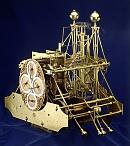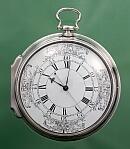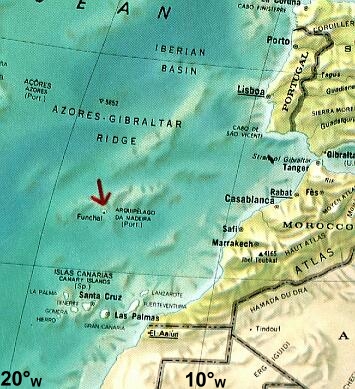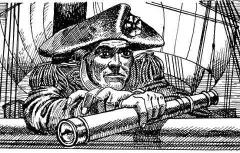


DUDLEY DIGGES, Captain of H.M.S.Deptford, looked up gloomily at the tightly swelling sails of his ship and then at the aft rail, where two hands were preparing to use a logline to estimate the ship's speed. The logline consisted of a flat piece of wood shaped like a sector of a circle, weighted at the bottom so that it floated upright. Attached to it was a long length of rope on a reel, knotted at 7 fathom (42 ft) intervals. At the end of the first 7 fathoms section there was one knot, after the next two knots, and so on. Also standing there was a midshipman holding a sandglass. One of the hands threw the log into the water. It hit the surface with a faint splash, and as the ship sailed away from it the hand carefully paid out the logline from the reel, which the other hand was holding aloft in his calloused fingers. The midshipman waited until a coloured piece of cloth tied onto the rope disappeared over the taffrail, and then he inverted the glass.
 The midshipman watched the sand grains trickle through the neck of the 30 second glass and eventually peter out. "Nip!" he piped in his yet-unbroken voice, and the old hand immediately stopped the line from paying out and bent to examine it.
The midshipman watched the sand grains trickle through the neck of the 30 second glass and eventually peter out. "Nip!" he piped in his yet-unbroken voice, and the old hand immediately stopped the line from paying out and bent to examine it."Seven and an 'alf" he muttered to the boy, who ran to report this to the officer of the watch.
"Beggin' your pardon, sir, seven and a half knots by the log" said the boy, raising his hand to his forelock in salute.
"Very good, Mr Farrely", said Lieutenant Seward without a hint of a smile, and he turned to the first mate who carefully added this news to a long list of similar information on the slate next to the helmsman. The slate bore a record of all relevant information to do with the operation of the ship and especially with its movement through the water: speed, wind direction, bearing, time of bearing change, drift—all had a part to play in calculating the ship's position on the globe. Later this information would be transcribed to the ship's logbook.
Digges had overheard the exchange between Farrely and Seward. The logline method tended to overestimate speed slightly, which was sensible; if you weren't exactly sure how far you were from landfall, it was better to underestimate the time to get there rather than arrive at it unexpectedly in the middle of the night. Seven knots or nautical miles per hour was not a bad speed considering the conditions but he wished he could double it, for he feared discontent among the crew. Nine days ago he had slipped his moorings at Portsmouth and taken the Deptford through Spithead bound for Jamaica, but it wasn't very long before he discovered he had been cheated by the provisioners: much of the cheese and many barrels of beer were not fit for consumption. In a fit of pique and much to the consternation of the crew, Digges had ordered the barrels be thrown over the side. The crew would definitely not be happy with only water to drink on the voyage across the Atlantic.
Digges had decided to make for Madeira, a tiny flyspeck on the map that was a Portuguese-administered island about 400 miles off the coast of Morocco, near the north-west tip of Africa. There he could get fresh provisions. The only trouble was, he first had to find it—not an easy task in the Year of Our Lord 1761, when navigation still involved a lot of estimation and guesswork about speeds, currents and drift. "Dead reckoning" (which some said evolved from ded., the abbreviation for "deduced reckoning") was anything but "dead accurate"; one could fix latitude (how far north or south of the equator) easily enough by measuring the angle between the horizon and the sun or the stars and then referring to a book of tables, but fixing longitude accurately was only possible by measuring the angle between the sun and the moon by day, or the moon and various stars at night, and then spending several hours working out some complicated formulae devised by astronomers. It was very easy to make a mistake, and you didn't have to be out by much to place yourself hundreds of miles from where you really were. And that was assuming you could see the celestial bodies. If the sky was overcast or it was foggy or raining, there was nothing you could do. No wonder so many ships foundered at sea—they often literally didn't know where they were.
It was such a serious problem that the British Parliament had passed The Longitude Act in 1714, which offered a prize of £20,000 for a "Practicable and Useful" method of determining longitude to within half a degree; £15,000 for a method to within two-thirds of a degree; and £10,000 for a method to within one degree. To put this in perspective, half a degree of longitude spans 30 nautical miles (34 statute miles) at the equator—hardly pinpoint accuracy but it indicates how haphazard navigation was at the time. And no-one had managed to claim the prize in nearly 50 years.




